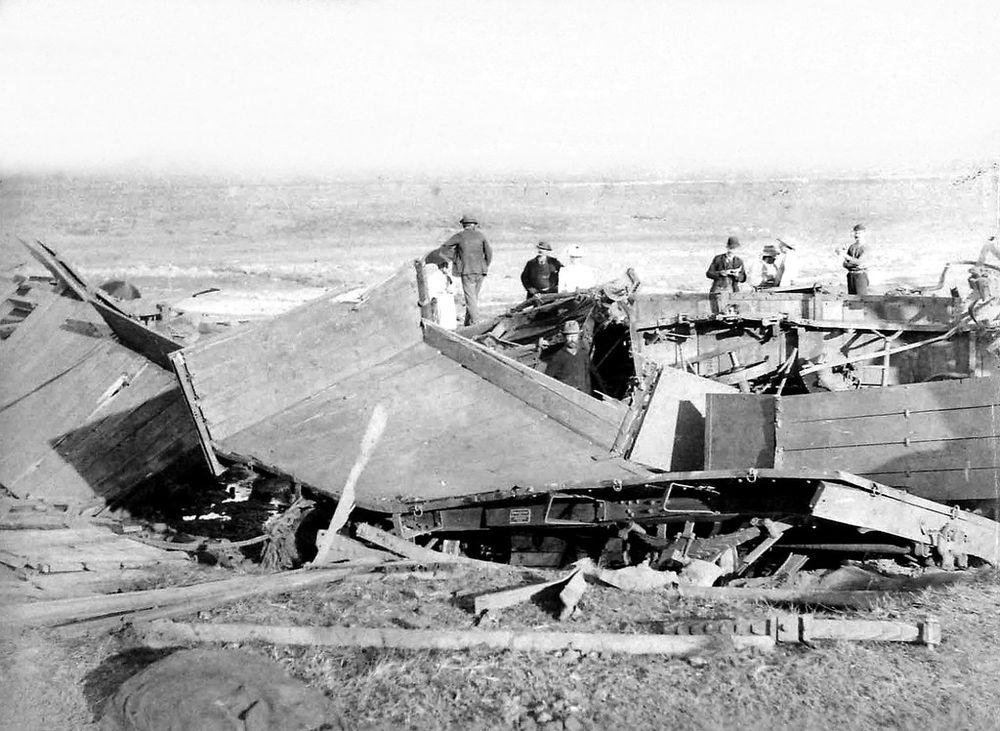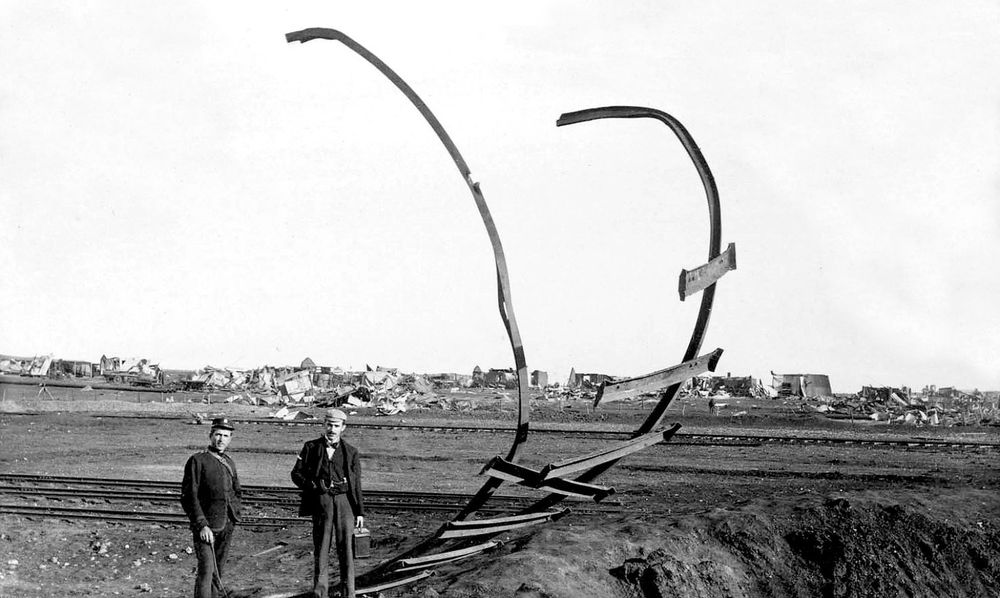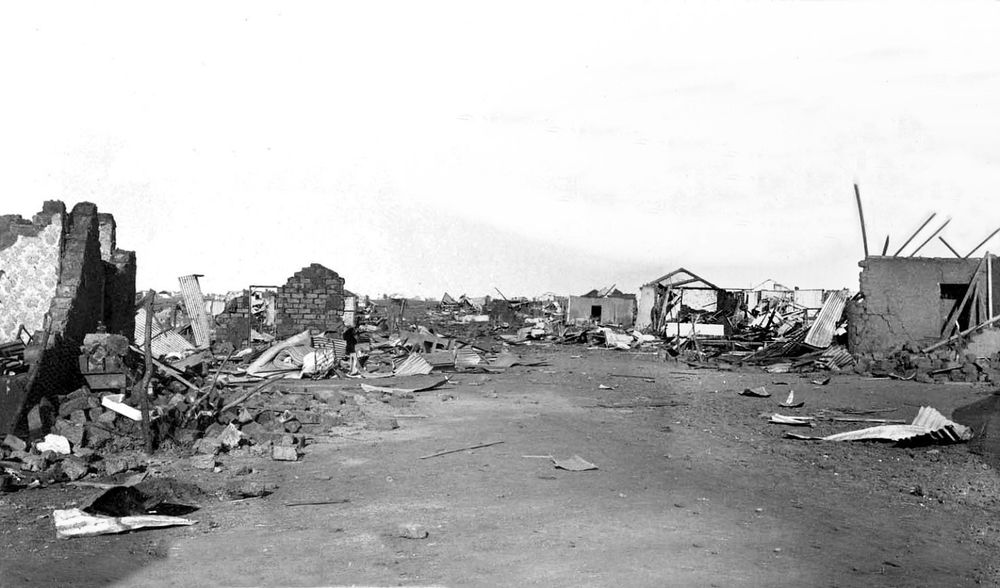The city of Johannesburg in South Africa was founded on gold after the precious metal was discovered on the Witwatersrand by Jan Gerrit Bantjes in 1884. As with any industry, and especially mining, the city endured many disasters and accidents. However, the one that took place in 1896 in Braamfontein, a suburb of Johannesburg, remains etched in the memories of its residents, as evidenced by the granite memorial in Braamfontein Cemetery, erected in memory of those who lost their lives in the great dynamite explosion.

A locomotive topples over due to the explosion.
It was Sunday, February 16, 1896, when a train pulled up at the Braamfontein station. Eight of its trucks were filled with dynamite—2,300 cases, each holding 60 lb of the explosive, or about 60 tons in all. The dynamite were destined for the mines and were stored at the Braamfontein ridge before they were delivered to the mines for use. That day, however, the magazines were full and there was no more space to store the latest consignment. The yard foreman advised to leave the dynamite on the trucks until storage space could be found. Because dynamites were using daily, the consignee’s representatives were confident that it would not be long before they could be unloaded.
The trucks were gently shunted into a goods siding where they would stay for the next three days, roasting under the hot February sun—the hottest time of the year. On Wednesday afternoon a gang of labourers arrived at Braamfontein station with their mule wagons to begin unloading the dynamite. One wagon had already been loaded and dispatched to the magazines when it became necessary to move the trucks to another part of the siding. A little shunting engine was called to assist. As the loco pilot backed the engine towards the coupling, he came a little too fast and the engine rammed into the stationary trucks.

Destroyed rolling stock following the explosion.
According to another version of the story, the shunting engine was pulling a different set of trucks but instead of pulling into an empty siding as intended, it accidentally entered the siding where the dynamite trucks were parked. When the pilot realized his mistake, he applied the brakes but it came too late and the train with 31 loaded trucks crashed into the dynamite truck.
As the couplings hit, the dynamite exploded with a tremendous roar that toppled houses around Johannesburg and rattled doors 200 kilometers away. The workers who were around the dynamite trucks were killed instantly, while the siding, trucks and wagons vaporised. The explosion left a crater 250 feet long, 60 feet wide and 40 feet deep. At each end of this crater twin sets of rails were contorted upwards.
In The Outlanders : The Men Who Made Johannesburg, Robert Crisp gives a vivid description of the mayhem that followed:
The ramshackle suburb of Braamfontein and the even more disreputable flimsiness of the coloured locations had been almost obliterated. Where ten minutes before had stood the homes and shops, warehouses and factories of a teeming working-class district, there was now nothing but scattered sheets of corrugated iron, shattered glass, grotesque piles of timber. Whole roofs had been lifted and dropped untidily hundreds of yards from the homes they had once covered. Through the wreckage wandered battered and bewildered men and women; only the dead lay unaware and silent.

The crater created by the dynamite explosion.
More than 70 people were killed and over 200 were injured. Some 3,000 people lost their homes. Those injured were rushed to the hospitals until they overflowed. The Wanderers Sports Grounds was then turned into an infirmary, while the yard of the Agricultural Show was organized to shelter the homeless.
A journalist at The Cape Argus placed the blame squarely on the Railway Company, denouncing their conduct as "gross carelessness and ignorance". The journalist went on to characterize it as "silly and grotesque, while causing a serious waste of time and power". In the course of the investigation, Friedrich Krieger, the director of the dynamite factory at Leeuwfontein, suggested that the handling of dynamite in this incident was substandard. Witnesses reported instances where railway workers would recklessly toss dynamite cases from the train onto the wagons.

A section of the track where the explosion took place.
Another act of carelessness linked to the disaster was that the detonators were stored on the same train as the dynamite. While the proximity of detonators alone wouldn't have caused the explosion, storing detonators near dynamite cases was expressly forbidden. Additionally, there was a lack of caution in the transportation of explosives. Wagon loads of dynamite would frequently speed through the town with only one driver overseeing them, and it wasn't uncommon to observe the driver smoking a pipe.
Turning to the quality of the explosives, samples of blasting gelatine removed from the trucks before the explosion underwent testing, revealing that the explosives were of high quality and in excellent condition.
Eventually, the Commission of Inquiry appointed to probe the possible causes of the disaster ruled that the blast occurred due to negligence. However, the commission conceded that the direct cause of the explosion could not be established, given that the explosives were of good quality and all the witnesses who could have testified whether the explosives were loaded and unloaded recklessly that day perished in the explosion.
The Braamfontein explosion left an indelible mark on Johannesburg's history and collective memory. In honor of this event, a memorial was erected in the Braamfontein Cemetery.

A scene of destruction resulting from the dynamite explosion in Braamfontein.

Part of the crater resulting from the explosion.

Mangled steel tracks after the explosion.
References:
# A Nauseous Pit of Death – the Braamfontein Dynamite Explosion, Blueplaques.co.za
# The small matter of £3: Dynamite, human folly and the Braamfontein explosion, 19 February 1896, Historia
# Unanswered Questions 120 Years after the Great Braamfontein Dynamite Explosion, The Heritage Portal












I am familiar with a few large man-made explosions, but this is the first time that I have read about this disaster.
ReplyDelete